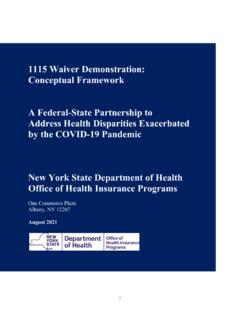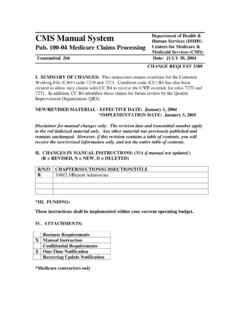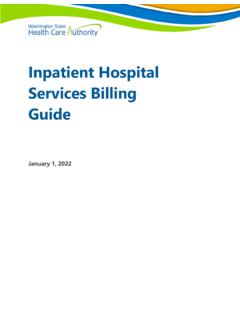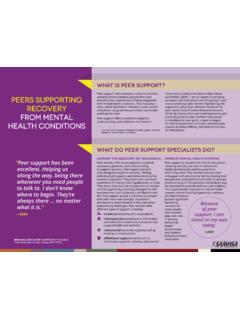Transcription of Specifications for the All-Cause Unplanned Readmission ...
1 Specifications for the All-Cause Unplanned Readmission Measure for 30 Days Post Discharge from inpatient Rehabilitation Facilities Current as of May 2, 2013. Table of Contents 1. Specifications for the All-Cause Unplanned Readmission Measure for 30 Days Post Discharge from inpatient Rehabilitation Facilities ..3. Measure Name ..3. Summary Description of the Measure ..3. Purpose of Measure ..3. Population ..5. Numerator ..6. Denominator ..7. Risk Adjustment and Statistical Method ..8. Sources of Data ..10. Appendix A Variables in the IRF Model for Unplanned Readmissions within 30 Days of Discharge to a Non-Acute Level of List of Tables 1 Additions to List of Planned Readmissions Currently Used in the Hospital-Wide Readmission Measure,* for Use in the IRF Measure.
2 10. List of Figures 1 IRF Discharge to Lower Level of Care, No Readmission .. 5. 2 IRF Discharge to Lower Level of Care, Unplanned Readmission .. 6. 3 IRF Discharge to Lower Level of Care, Planned Readmission .. 6. Current as of May 2, 2013 Page ii 1. Specifications for the All-Cause Unplanned Readmission Measure for 30 Days Post Discharge from inpatient Rehabilitation Facilities Measure Name All-Cause Unplanned Readmission Measure for 30 Days Post Discharge from inpatient Rehabilitation Facilities Summary Description of the Measure This measure estimates the risk-standardized rate of Unplanned , All-Cause readmissions for patients discharged from an inpatient rehabilitation facility (IRF) who were readmitted to a short- stay acute-care hospital or a long-term care hospital (LTCH), within 30 days of an IRF.
3 Discharge. The measure will be based on data for 24 months of IRF discharges to lower levels of care or to the community. A risk-adjusted Readmission rate for each facility begins with the calculation of the ratio of the predicted number of readmissions at the facility divided by the expected number of readmissions for the same patients if treated at the average facility. This standardized risk ratio is then multiplied by the mean rate of Readmission in the population ( , all Medicare fee-for-service [FFS] patients). The risk adjustment for the predicted (numerator) and expected (denominator) number of readmissions is described below. This risk-standardized ratio is the essential indicator in differentiating a facility's effects on Readmission rates.
4 For this measure, readmissions that are usually for planned procedures are excluded. 1 The measure definition is further described below. Purpose of Measure Because the measure tracks patients for 30 days after discharge from an IRF, it will provide information to providers that is not easily available to them currently. Rates of Readmission are related to quality of care, particularly in the transition from the hospital to the next care setting. Though facility-level readmissions are not expected to be zero, elevated risk-adjusted Readmission rates are indicators that there are opportunities for improvements in patient care and transitions of care. 1. Planned procedures were determined by clinical panels convened for the hospital-wide Readmission measure and supplemented for the IRF measure.
5 They are defined by a table of ICD-9 procedure codes that may appear on a hospital claim, with exceptions to the status of planned when certain principal diagnosis codes appear on a claim. Current as of May 2, 2013 3. In 2010, almost 360,000 Medicare FFS beneficiaries received care in roughly 1,180 IRFs nationwide. 2 In 2011, about 371,000 Medicare beneficiaries received care in roughly 1,165 IRFs nationwide. 3 For patients discharged from an IRF, the unadjusted rate of Readmission to a short- stay acute-care hospital or an LTCH in the 30 days after an IRF discharge was about 15 percent (RTI analysis of 2010 2011 Medicare Claims data). With such a large proportion of patients being readmitted to an acute level of care in either a short-stay acute-care hospital or an LTCH, CMS proposes 4 to monitor the Readmission rates for each IRF to improve patient care and transitions of care.
6 By doing so, CMS hopes to reduce IRF Readmission rates that are inappropriately high and improve patient safety and quality of care. Reducing avoidable readmissions can also reduce costs to the Medicare program. Readmission rates are affected not only by the characteristics of patients, but by complex and critical aspects of care such as communication between providers or between providers and patients; prevention of and response to complications; patient safety; and coordinated transitions to the outpatient environment. 5 Readmissions have been identified as being sensitive to improvements in coordination of care and discharge planning for patients. Literature on readmissions focuses mainly on discharges from short-stay acute-care hospitals.
7 However, processes that affect Readmission , such as discharge planning and transition of care, communications, and care coordination, also occur at other inpatient facilities, such as the IRFs, and may affect Readmission rates. Randomized controlled trials in short-stay acute-care hospitals have shown that improvements in the quality of care during the initial admission; improvement in communication with patients, their caregivers, and their clinicians; patient education;. predischarge assessment; and coordination of care after discharge can directly reduce 30-day Readmission rates by 20 to 40 percent. A 2011 meta-analysis of such randomized clinical trials found evidence that interventions associated with discharge planning helped to reduce Readmission rates.
8 6 Evidence that hospitals have been able to reduce Readmission through these quality improvement initiatives illustrates the degree to which hospital best practices in these areas can improve Readmission rates. Hospital-wide, all-condition Readmission measures could portray a broader sense of the quality of care in hospitals and hence, can promote hospital quality improvement and better inform consumers about care quality. 7. 2. Medicare Payment Advisory Commission: Report to the Congress: Medicare Payment Policy, March 2012; see Chapter 9, inpatient rehabilitation facility services, pp. 233 253. 3. Medicare Payment Advisory Commission: Report to the Congress: Medicare Payment Policy, March 2013; see Chapter 10, Long-term care hospital services, pp.
9 215 233. 4. See FY 2014 IPPS/LTCH PPS Notice of Proposed Rule Making accessible at , search for FY 2014 IPPS/LTCH PPS Proposed Rule. 5. See FY 2013 IPPS/LTCH PPS Final Rule accessible at ; see 77 FR 53619 through 53623 and 53667 through 53672. Publication date: August 31, 2013. 6. Naylor, , Aiken, , Kurtzman, , et al. The importance of transitional care in achieving health reform. Health Affairs 30(4):746 754. 2011. 7. See FY 2013 IPPS/LTCH PPS Final Rule accessible at ; see 77 FR 53619 through 53623 and 53667 through 53672. Publication date: August 31, 2013. Current as of May 2, 2013 4. Population The population being tracked in the measure includes IRF Medicare FFS patients, aged 18 years and older, who are discharged to lower levels of care or to the community.
10 This group includes patients discharged from the IRF to skilled nursing facilities or home health care, or patients who are discharged to the community or nursing homes. It excludes patients who are transferred to another IRF, short-stay acute-care hospital, or an LTCH on the day of discharge or the day following the day of discharge from the IRF. To clarify the relationships between events used to define the population included in this measure, Figures 1 through 3 present three different scenarios. In Figure 1, the patient has a prior short-term acute-care hospital stay within 30 days prior to the IRF admission. There may have been program interruptions during the IRF stay, which are not considered in the measure. Since the patient is not readmitted in the 30-day post-discharge window, the patient is included in the measure as No Readmission .
















